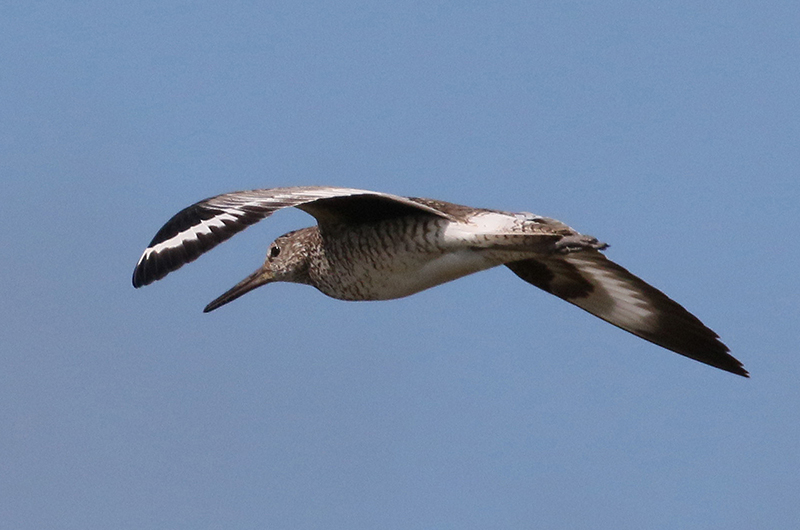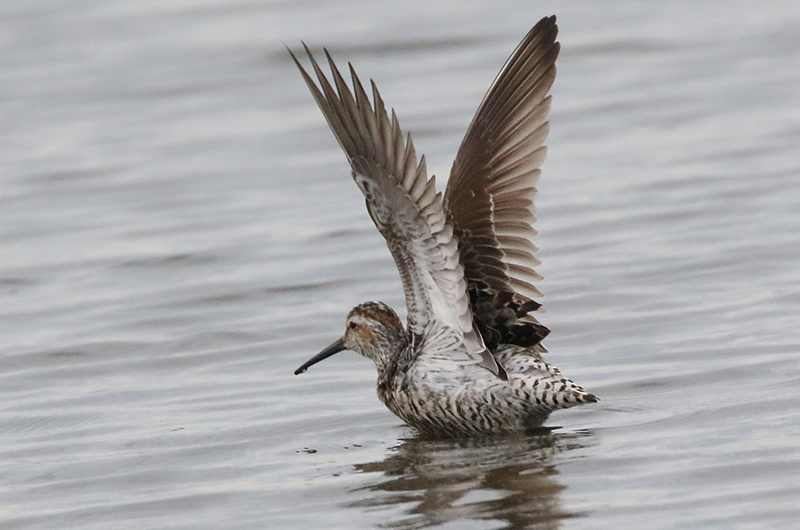Birders often associate migration with the arrival of species that have not been here for months or more. Shorebirds pass through on their way north from April to early June – now they are arriving on their way south in July; for example, short-billed dowitchers are here now. And we associate migration with post-breeding dispersal where birds like the royal tern spread northward before they start their southward migration. Is the scarlet tanager I heard singing at Cedar Tree Neck on July 25 – it has not been there since May – a southbound migrant or a post-breeding disperser?
There is yet a third type of migration that is harder to detect. The departure of our breeding species often goes unnoticed until one day we ask, “Where did all the yellow warblers go?” Most of them are gone now, as are most of the American redstarts. In May and June, I could easily find 15 breeding pairs of each species at Cedar Tree Neck. On July 25, I could only find one yellow warbler and three redstarts, despite the ease of finding these very active warblers that constantly flit from one low perch to another in search of food. Did they leave a month ago or yesterday? That question is hard to answer.
Bird Sightings
Scott Stephens reports at least three golden-crowned kinglets in the State Forest on July 23. They are winter residents that are not known to nest here. Migration data from ebird shows that they leave for their northern nesting grounds in April and are not scheduled to start returning until late September. So what are they doing here?
The focus of shorebird migration this week has switched to Norton Point Beach. Four of us made separate trips to those tidal flats. On July 23, Warren Woessner visited there and his best bird was a single black tern in the flock of common and least terns. He also saw six spotted sandpiper, two least sandpiper, three semipalmated plovers, three short-billed dowitchers, eight sanderling, three piping plover, a greater yellowlegs, willets and American oystercatchers. That day, Matt Pelikan added the first ruddy turnstone of the season. There was an exceptionally low tide on the morning of July 25. The western end of Mattakesett Bay was completely exposed except for the channel of Herring Creek. I basically saw the same birds as above and added two black-bellied plover, six semipalmated sandpipers, seven roseate terns, a black skimmer, a green heron and a black-crowned night-heron. My strangest sighting was three fledgling brown-headed cowbirds, as they are not expected on tidal flats.
That same day, Warren Woessner was arriving as Lanny McDowell was leaving; they each saw many of the same species and added a black tern and two red knots. Of the sanderling, Mr. McDowell observed sanderling catching “the featured soupe du jour of flying ants, right at the high edge of the receding water.” After he left the beach, he spotted the sandhill crane at The Farm Institute.
At Black Point Pond on July 24, many of the same species were seen by Lanny McDowell and Pete Gilmore – they also spotted two breeding plumage stilt sandpipers, which were also observed by Jeff Peters. This species is usually seen in its mostly grey, non-breeding plumage.
The troika of Pat Hughes, Hal Minis and Susan Whiting visited Lobsterville and spotted semipalmated plover, ruddy turnstone, sanderling, least sandpiper, semipalmated sandpiper and greater yellowlegs. Rob Bierregaard added a whimbrel from the western end of Black Point Pond on July 25 and he saw both spotted and least sandpipers near Town Cove on Tisbury Great Pond on July 24. The whimbrel was also seen by Jeff Peters on July 24, while the day before, Francesca Zeta spotted a whimbrel at the eastern end of Norton Point Beach and I observed one at Sheriff’s Meadow Sanctuary.
Gus BenDavid reports that a great egret visited a pond in his yard today, joining the daily visitors of great blue heron and spotted sandpiper. The osprey nesting in his yard has fledged three young. Rob Bierregaard was here this past week conducting his osprey survey with the help of volunteers from Felix Neck and documented a record 106 nests with an increasing number of natural nests in trees rather than on osprey poles. Lots of young fledged this year, with an average of about one and a half chicks per pair.
David Benvent has been doing a lot of birding for the Young Birders Collective Big Year. At Felix Neck on July 26, his highlights included a chimney swift, spotted sandpiper, two snowy egrets, two saltmarsh sparrows and three eastern bluebirds. Along Waldrons Bottom Road, he spotted an eastern wood-pewee. On July 25 aboard the Steamship Authority he saw a laughing gull and a roseate tern.
Irene Ziebarth had a great blue heron land in her yard near the headwaters of Mill Brook. And John Banks reports a great blue heron flew over Waterview Farm toward Sengekontacket Pond on July 23.
Robert Culbert is an ecological consultant with Nature Watch LLC living in Vineyard Haven.











Comments (1)
Comments
Comment policy »